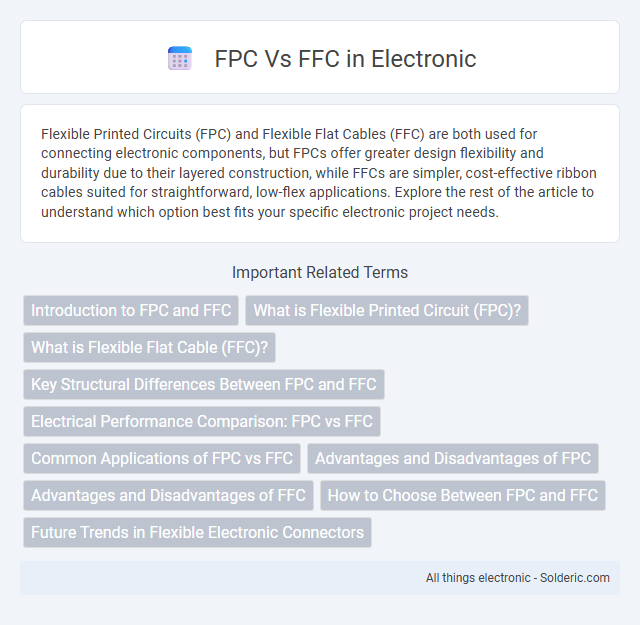Flexible Printed Circuits (FPC) and Flexible Flat Cables (FFC) are both used for connecting electronic components, but FPCs offer greater design flexibility and durability due to their layered construction, while FFCs are simpler, cost-effective ribbon cables suited for straightforward, low-flex applications. Explore the rest of the article to understand which option best fits your specific electronic project needs.
Comparison Table
| Feature | FPC (Flexible Printed Circuit) | FFC (Flat Flexible Cable) |
|---|---|---|
| Structure | Flexible circuit with etched copper traces on a flexible substrate | Flat ribbon cable with parallel conductors embedded in plastic film |
| Flexibility | Highly flexible, supports complex shapes and bends | Flexible but mainly flat and linear |
| Thickness | Thinner, typically 0.05 - 0.2 mm | Usually thicker, around 0.3 - 0.5 mm |
| Conductors | Copper traces patterned on film | Parallel stranded or solid wires |
| Applications | Complex circuits in smartphones, cameras, medical devices | Simple interconnections in laptops, printers, display units |
| Cost | Higher, due to complex manufacturing | Lower, easy mass production |
| Reliability | Better mechanical and electrical performance | Less durable under repeated flexing |
Introduction to FPC and FFC
FPC (Flexible Printed Circuit) and FFC (Flexible Flat Cable) are essential components in modern electronics, designed to provide flexible connections in confined spaces. FPC consists of a flexible insulating material with conductive copper traces etched onto its surface, allowing complex circuit patterns and high-density connections. FFC, by contrast, typically features a flat ribbon of conductors enclosed between two layers of insulating film, simplifying assembly and reducing thickness for your specific device needs.
What is Flexible Printed Circuit (FPC)?
Flexible Printed Circuit (FPC) is a type of electronic circuit built on a flexible plastic substrate, typically polyimide, allowing circuits to bend and fold without damaging the conductive pathways. FPCs are widely used in compact electronic devices such as smartphones, cameras, and wearable technology due to their space-saving design and ability to accommodate complex geometries. Unlike Flat Flexible Cable (FFC), which has a flat cable with parallel conductors, FPCs offer greater design versatility and enhanced durability for intricate electronic applications.
What is Flexible Flat Cable (FFC)?
Flexible Flat Cable (FFC) is a type of flat, flexible ribbon cable composed of multiple metallic conductors laminated between two layers of flexible insulating material. FFCs are widely used in electronic devices to connect printed circuit boards (PCBs) in tight or compact spaces due to their thin profile and bendable design. Unlike Flexible Printed Circuits (FPC), FFCs lack embedded circuitry and rely on parallel conductor strips, making them simpler and more cost-effective for basic signal transmission.
Key Structural Differences Between FPC and FFC
FPC (Flexible Printed Circuit) features a thin, flexible polymer substrate with copper traces embedded within multiple layers, offering durability and complex circuit layouts. FFC (Flexible Flat Cable) consists of flat, ribbon-like conductors encased in a single layer of insulating film, designed primarily for simple, low-profile connections. Understanding these structural differences helps you choose the right type for applications requiring either sophisticated flexibility or straightforward flat cabling.
Electrical Performance Comparison: FPC vs FFC
FPC (Flexible Printed Circuit) offers superior electrical performance compared to FFC (Flat Flexible Cable) due to its enhanced signal integrity and reduced electromagnetic interference. The copper traces in FPC are precisely etched and laminated onto a flexible substrate, ensuring consistent impedance and reliable high-frequency signal transmission. Your choice between FPC and FFC will depend on the application's requirement for durability and electrical reliability.
Common Applications of FPC vs FFC
Flexible Printed Circuits (FPC) are commonly used in complex electronic devices such as smartphones, wearables, and automotive dashboards where durability and compact design are critical. Flat Flexible Cables (FFC) are frequently implemented in simpler, cost-sensitive applications like laptop displays, printers, and consumer electronics due to their ease of installation and flexibility. Both FPC and FFC serve vital roles in modern electronics, with FPC favored for intricate circuitry and FFC preferred for straightforward, high-volume interconnections.
Advantages and Disadvantages of FPC
Flexible Printed Circuits (FPC) offer several advantages, including high-density circuit design, excellent flexibility, and improved reliability in compact electronic devices. Their ability to fit complex shapes and reduce wiring errors makes them ideal for modern electronics, but they tend to be more expensive and less durable under extreme mechanical stress compared to Flexible Flat Cables (FFC). Your choice of FPC should consider factors like cost, application environment, and required flexibility for optimal performance.
Advantages and Disadvantages of FFC
FFC (Flat Flexible Cable) offers advantages such as easy bending, lightweight design, and cost-effectiveness compared to FPC (Flexible Printed Circuit). However, FFC has disadvantages including lower durability, limited resistance to environmental factors, and reduced capability for complex circuit integration. These limitations make FFC less suitable for applications requiring high reliability and intricate circuitry.
How to Choose Between FPC and FFC
Choosing between Flexible Printed Circuit (FPC) and Flexible Flat Cable (FFC) depends on application requirements such as flexibility, space constraints, and electrical performance. FPC offers superior flexibility, higher density connections, and better durability for complex, high-reliability electronics, while FFC is cost-effective and suitable for simpler, lower-density interconnections. Evaluating factors like bend radius, current capacity, signal integrity, and manufacturing complexity helps determine the optimal choice.
Future Trends in Flexible Electronic Connectors
Future trends in flexible electronic connectors emphasize the integration of innovative materials such as graphene and conductive polymers to enhance durability and conductivity in FPCs (Flexible Printed Circuits) over FFCs (Flexible Flat Cables). Advances in miniaturization and 3D printing technologies are enabling more compact, lightweight FPC designs that support higher data transmission rates and improved mechanical flexibility. The growing demand for wearable devices, IoT applications, and foldable displays is accelerating the adoption of FPCs due to their superior reliability and versatility compared to traditional FFCs.
FPC vs FFC Infographic

 solderic.com
solderic.com